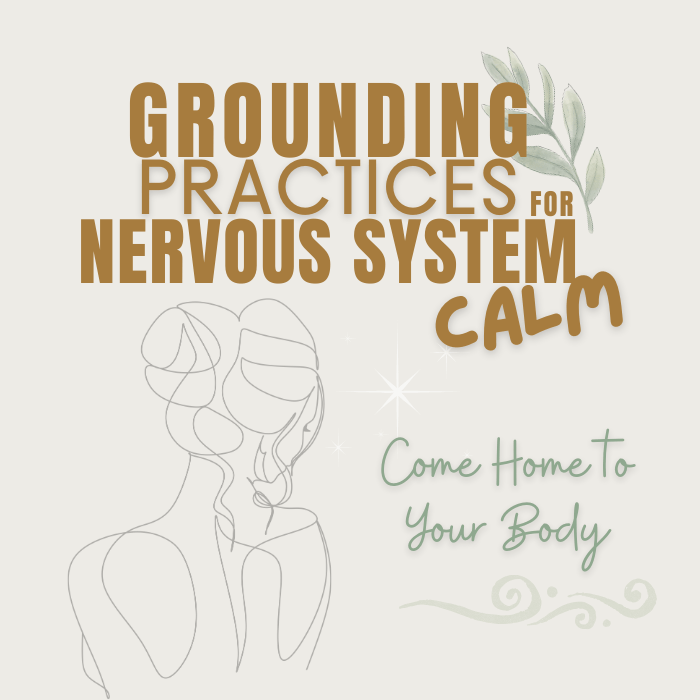Sometimes the most healing thing we can do is simply return to the ground beneath us.
When life feels overwhelming — when emotions swell, thoughts spiral, or your body holds tension like a clenched fist — nervous system grounding techniques can bring you back to steadiness.
Grounding is not a magic trick to erase emotions or stop thoughts.
It is a way of coming home to your body in the present moment, where safety, clarity, and breath can return.
In times of stress, your nervous system often leaps into ancient survival responses: fight, flight, freeze, or fawn.
Grounding creates a bridge back to a felt sense of safety — a soft signal to your system that you are here, and you are safe enough now.
Some links on this page are affiliate links. If you choose to purchase through them, it supports this site at no extra cost to you. Thank you for your support. 🤍
Why Grounding Practices Matter for Nervous System Healing
When the body feels unsafe, healing work can feel impossible.
New ideas slide off. Self-compassion feels unreachable. Even joy can seem suspicious.
Without a grounded body, healing becomes an exhausting battle.
But when you are grounded — when your body feels your feet on the earth, your breath in your chest —
your system softens.
Healing can come through with more ease.
Grounding doesn’t “fix” you.
It connects you more with the truth.
If you’d like to understand why your nervous system holds onto survival patterns even after danger has passed, you might enjoy this guide:
What Is Nervous System Dysregulation →
Signs You May Need Grounding
You might benefit from grounding if you notice:
- Racing or spiraling thoughts
- Feeling disconnected from your body
- A sense of floating above yourself
- Panic, dread, or “freezing” in place
- Overwhelm that feels impossible to navigate
- Restlessness or sudden exhaustion without clear cause
They are signs your body is seeking a softer anchor.
Gentle Grounding Practices for Somatic Healing
Here are some simple, powerful ways to bring yourself back into your body:
1. Feel Your Feet
- Sit or stand quietly.
- Place your attention on the soles of your feet.
- Notice the weight, the texture of the ground beneath you.
- Imagine roots growing from your feet deep into the earth.
🪷 Even 30 seconds of this can shift your entire inner landscape.
2. Hold a Grounding Object
- Find a stone, a piece of wood, a crystal, or a small object with comforting texture.
- Hold it in your hand.
- Notice its temperature, weight, texture.
- Let your senses anchor you into the now.
3. Breath with a Longer Exhale
- Breathe in gently for a count of 4.
- Breathe out slowly for a count of 6 or 7.
- Repeat for 2–5 minutes.
A longer exhale signals your vagus nerve — your body’s calming brake pedal — to engage and soften your stress response.
4. Gentle Body Pressure
- Place a hand over your heart, your belly, or the sides of your ribcage.
- Apply light, comforting pressure.
- Let your body know: “I am here. I am holding you.”
Touch can be a powerful grounding force, especially for nervous systems shaped by early fear or disconnection.
5. Anchor into Your Surroundings
- Name 5 things you can see.
- Name 4 things you can touch.
- Name 3 things you can hear.
- Name 2 things you can smell.
- Name 1 thing you can taste.
✨ This “5-4-3-2-1” practice gently orients your brain to present safety.
Grounding is not a magic trick to erase emotions or stop thoughts.
It is a way of coming home to your body in the present moment, where safety, clarity, and breath can return.
If you’d like to explore a trauma-sensitive overview of grounding, this gentle guide explains the healing power of grounding beautifully.
Bonus Practice: Weighted Warmth for Soothing Support
Place a weighted heating pad across your shoulders or chest. The combination of warmth and pressure can offer a sense of being held — especially calming for nervous systems shaped by early disconnection or chronic stress.
A Truth About Nervous System Grounding
Grounding is not about perfection.
It’s not about never spiraling or feeling afraid again.
It’s about building a relationship with your body, breath, and senses —
so that when the waves of life rise, you have an anchor waiting.
Every small grounding moment you offer yourself strengthens your system’s ability to return to calm more quickly.
It is not weakness to need grounding.
It is wisdom.
🌿 Frequently Asked Questions
How often should I practice grounding?
As often as feels nourishing.
Small grounding moments scattered through the day are often more powerful than one long session.
What if grounding feels uncomfortable?
Sometimes, especially after trauma, returning attention to the body can feel scary.
Start small. Even placing a hand over your heart for 10 seconds is enough.
You are allowed to build trust with your body slowly.
Can grounding help with chronic anxiety?
Yes.
While grounding is not a “cure,” it can soften anxiety’s hold by teaching your nervous system to return to regulation more gently and often.
Grounding opens the door to deeper emotional healing. If it feels right, you could continue here:
Healing Emotional Patterns →
Your unfolding is already underway — and it’s beautiful.

